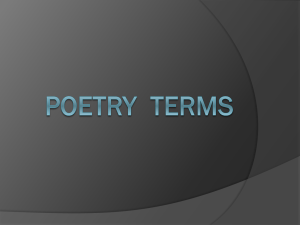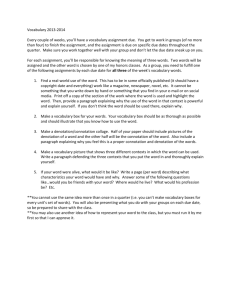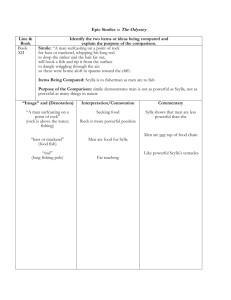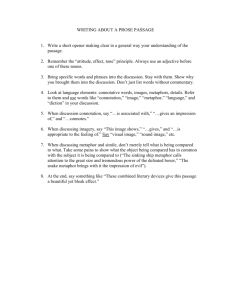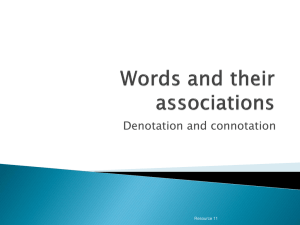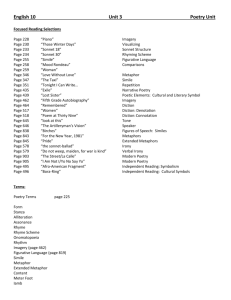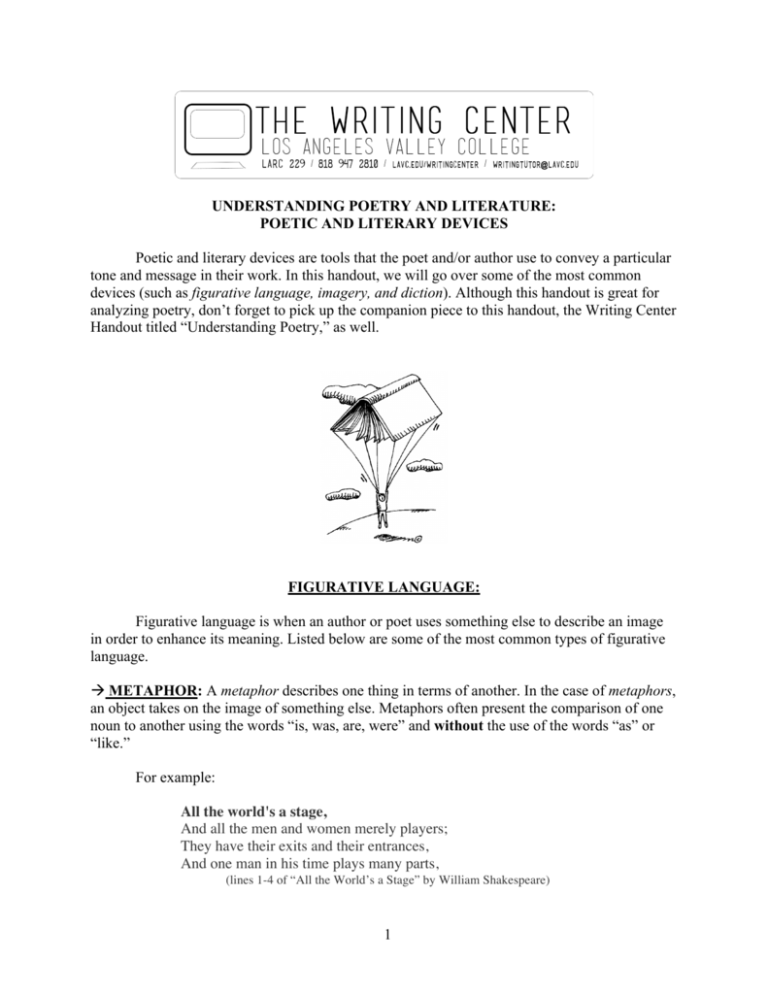
UNDERSTANDING POETRY AND LITERATURE:
POETIC AND LITERARY DEVICES
Poetic and literary devices are tools that the poet and/or author use to convey a particular
tone and message in their work. In this handout, we will go over some of the most common
devices (such as figurative language, imagery, and diction). Although this handout is great for
analyzing poetry, don’t forget to pick up the companion piece to this handout, the Writing Center
Handout titled “Understanding Poetry,” as well.
FIGURATIVE LANGUAGE:
Figurative language is when an author or poet uses something else to describe an image
in order to enhance its meaning. Listed below are some of the most common types of figurative
language.
METAPHOR: A metaphor describes one thing in terms of another. In the case of metaphors,
an object takes on the image of something else. Metaphors often present the comparison of one
noun to another using the words “is, was, are, were” and without the use of the words “as” or
“like.”
For example:
All the world's a stage,
And all the men and women merely players;
They have their exits and their entrances,
And one man in his time plays many parts,
(lines 1-4 of “All the World’s a Stage” by William Shakespeare)
1
In this example, the “world” takes on the image of a stage in order to perhaps state that life is an
arena comprised of theatrical scenes and acts. This is a metaphor because the world IS the stage
in the poem.
Other examples include:
* She is the apple of my eye.
* His love was my healing grace.
* These blooming flowers are a sign of good things to come.
* Her words were sharp knives.
NOTE! Metaphors are not always as obvious as “is” or “was.” Sometimes, an
image is metaphoric because of how it is described. For example, in the poem
“Living in Sin” by Adrienne Rich, the speaker states that “each separate stair
would writhe / under the milkman’s tramp.” In this case, the inanimate object
(the “stair”) behaves (“writhes”) like an animal, specifically a snake.
SIMILE: A simile is a type of comparison in which two objects are compared to one another
using the words “as” or "like."
For example:
Your teeth are like stars;
They come out at night.
They come back at dawn
When they’re ready to bite.
(“Your Teeth” by Denise Rogers)
In this case, the poet uses a simile to compare “teeth” to the “stars,” and she continues the
comparison by providing evidence for why they are similar, as they both “come out at night.”
Other examples include:
* He fights like a lion.
* He swims as fast as a fish.
* He slithers like a snake.
* He runs like a cheetah.
* She kicks like a mule.
ANALOGY: An analogy is comparable to a metaphor and a simile in that it shows how two
different things are similar, but in a more complex way. Rather than a figure of speech, an
analogy is more of a logical argument. The presenter of an analogy will often demonstrate how
2
two things are alike, or analogous, by pointing out shared characteristics.
For example:
The white mares of the moon rush along the sky
Beating their golden hoofs upon the glass heavens;
The white mares of the moon are all standing on their hind legs
Pawing at the green porcelain doors of the remote heavens
Fly, Mares!
(lines 1-5 of “A Decade” by Amy Lowell)
In this example, an analogy is used to compare mares and clouds. The image of the mares is used
to construct the image of clouds moving in the sky. Lowell is making an argument, in a way, by
using evidence to show that white mares look similar to white clouds.
Other examples include:
* “A glove is to a hand as paint is to a wall.”
The analogical argument here is that both gloves and paint are put on hands and
walls, respectively.
* “Citizens are to a president as a solar system is to a galaxy.”
The analogical argument here points out that citizens serve as a foundation for a
president in a way that is similar to how a solar system serves as a foundation for
the galaxy.
* “Cameron's house is like a museum. It's very cold, and very beautiful, and you're not
allowed to touch anything.”
Again, this statement is making an analogical analysis. Although this statement is
very metaphorical, what makes it an analogy is the argument made—evidence is
provided for the claim.
METONYMY: A metonymy is another type of metaphor in which a noun or idea is not called
by its own name, but rather by the name of something associated with that noun or idea. For
instance, "London," as it is the capital of the “United Kingdom,” could be used as a metonym for
the “British Government.”
For example:
And O ye high-flown quills that soar the skies,
And ever with your prey still catch your praise
(from the eighth stanza of “The Prologue” by Anne Bradstreet)
In this case, “high-flown quills” represents literary critics and the pens they use to write their
critique, or catch their “prey.”
3
Other examples include:
* The silver screen = movies.
* The crown = the ruling monarch.
* “He writes a fine hand" meaning good handwriting.
* “The pen is mightier than the sword," meaning literary power is superior to military
force.
* “The House was called to order,” meaning the members in the House.
SYNECDOCHE: A synecdoche (pronounced: si-nek-da-kee) is another type of metaphor in
which a part is used to represent a whole, or vice versa.
For example:
“All hands on deck, and that young lubber's late!”
Somehow you struggle up the deck's mad slope;
(lines 23-24 of “All Hands on Deck” by Bill Adams)
In this case, the word "hand” represents the entirety of a sailor. Essentially, this synecdoche
means that all the sailors should come to the deck.
Other examples include:
*“Twenty sails came into the harbor.”
This means that twenty ships came into the harbor, and the part of the ship, the
“sail,” is used to refer to the whole “ship.”
*“Cleveland plays Boston tonight.”
“Cleveland” (the city) = its baseball team.
*“The world treated him badly.”
The whole “world” did not treat him badly—only a part.
HYPERBOLE: A hyperbole is a figure of speech in which all statements are exaggerated for
emphasis.
For example:
Ares roared
As loudly as nine or ten thousand men
In the thick of a fight, . . .
So terrifying was the cry he raised.
As a dark cloud in the sky
(lines 859-864 of The Iliad by Homer)
4
In this piece, the poet is exaggerating Ares’ cry by comparing it to the cries of “nine or ten
thousand men / In the thick of a fight.” The poet does this to emphasize the darkness and sorrow
of the sound.
Other examples include:
* His stomach was as big as Milwaukee. (His stomach was very large.)
* These books weigh a ton. (These books are heavy.)
* I could sleep for a year. (I could sleep for a long time.)
* The path went on forever. (The path was very long.)
* I'm doing a million things right now. (I'm very busy.)
* I could eat a horse. (I'm very hungry.)
PERSONIFICATION: A personification is a type of metaphor that gives human
characteristics to animals, inanimate objects, or concepts.
For example:
Because I could not stop for Death,
He kindly stopped for me;
The carriage held but just ourselves
And Immortality.
(lines 1-4 of “712” by Emily Dickinson)
In this example, death is a concept that is described as if it were a suitor that is accompanying the
speaker in a carriage; death is given human characteristics.
Other examples include:
*The camera loves me.
*Art is a jealous mistress.
*Wind yells while blowing.
*Opportunity knocked on the door.
*The sun greeted me this morning.
IMAGERY:
Imagery is one of the most important aspects of poetry and literature. Literature often
uses vivid and striking imagery to enhance a storyline; a story’s true essence is defined by how
vividly the reader can see, smell, taste, and hear the events of the story. On the other hand, since
poems are typically short, there are no characters or long scenes in which we can determine what
is happening in the poem. Poetry usually needs to appeal to an audience using striking and vivid
imagery. Below are some of the most common types of imagery.
SYMBOLISM: This is when a concrete thing or action implies a hidden meaning, such as
how a “clock” represents “time,’ or how “glasses” represent “wisdom.” Many poets and authors
use metaphors, similes or analogies to transform images into symbols to represent a certain idea
5
or quality about the image.
For example:
My heart leaps up when I behold
A rainbow in the sky ...
(lines 1-2 of “My Heart Leaps Up When I Behold” by William Wordsworth)
In this example, a “rainbow” is used as a symbol of hope, i.e. “the pot of gold at the end of the
rainbow.”
SENSORY PERCEPTION: Poetry and literature often try to evoke sensations associated
with sight, sound, smell, touch, and taste. Think of what you’re reading as a painting with words.
To best understand a poem, pick out and decode what sensations certain images in a poem make
you feel. This method also works for literature.
For example:
The winter evening settles down
With smell of steaks in passageways.
Six o'clock.
The burnt-out ends of smoky days.
And now a gusty shower wraps
The grimy scraps
Of withered leaves about your feet
And newspapers from vacant lots;
The showers beat
On broken blinds and chimney-pots,
And at the corner of the street
A lonely cab-horse steams and stamps.
And then the lighting of the lamps.
(“Preludes” by T.S. Eliot)
In this case, the poet uses sensory perception in order to make the language of the poem striking.
Readers can actually experience the “smell of steaks in passageways,” as well as the smell of
“burnt-out ends of smoky days.” The line “a gusty shower wraps / The grimy scraps” helps the
reader to feel the wrapping and the thick grime. Finally, the reader can hear the specific “showers
beat / On broken blinds and chimney-pots,” as well as how the cab-horse steams and stamps.”
DICTION:
Diction refers to word choice in a poem. Certain words can convey more than one
definition, which can suggest specific types of meaning. While one writer uses slang, the other
may use formal language. What is the significance of this difference? While reading, remember
to ask yourself why the writer may have used a certain word. Is the word choice formal or
6
informal? Are they using particular words to relay a hidden meaning?
DENOTATION: The denotation of a word is its literal meaning, or dictionary definition.
CONNOTATION: The connotation of a word is its emotional and cultural meaning, or the
implied meaning.
Denotation and connotation can be applied to the same word. For example, the words “home,”
and “residence” have the same denotation (“the place where one lives”), but the connotation of
each word is very different. The connotation of “residence” is formal and cold—something that a
real estate agent or landlord may sue. Meanwhile, the connotation of “home” is familiar and
warm—something that is used by the average person.
For a more in-depth look at denotation and connotation, please check out the
Writing Center Handout titled “Denotation and Connotation.”
EXERCISE:
Closely read the following excerpts taken from various forms of creative writing. Can you
identify the types of figurative language, imagery, and diction used? Remember that there
may be more than one technique used (i.e. a passage can contain a metaphor and a simile at
the same time.) Please refer to the example below for a guide on how to complete the
exercise, and remember that no answer is incorrect if you can prove your interpretation
with evidence.
EXAMPLE: The following is an excerpt from the novel Fat City by Leonard Gardner:
Occasionally there was a gust of wind, and he was engulfed by
sudden rustling and flickering shadows as a high spiral of onion
skins fluttered about him like a swarm of butterflies.
The aforementioned excerpt uses simile, symbolism, and connotation.
7
Please explain with examples:
The statement “onion skins fluttered about him like a swarm of butterflies” is a
simile because the author is using “like” or “as” to show a comparison between
fluttering onion skins and fluttering butterflies. Also, the “rustling and
flickering shadows” can symbolize fear and darkness, because rustling and
shadows are both scary sounds/images. I also think it is interesting that the
author uses the word “flutter” to describe onion skins. Onion skins are usually
considered yucky, but the connotation of “Flutter” is very delicate, which leads
me to think that the author wanted the reader to see the onion skins in a
delicate and dainty way. The onion skins seem symbolic of something as well.
EXERCISE #1: The following is an excerpt from “Revenge of the Pork Person” by Dave Barry:
I have never met a woman, no matter how attractive, who wasn't
convinced, deep down inside, that she was a real woofer. Men tend
to be just the opposite. A man can have a belly you could house
commercial aircraft in and a grand total of eight greasy strands of
hair, which he grows real long and combs across the top of his
head so that he looks, when viewed from above, like an egg in the
grasp of a giant spider, plus this man can have B.O. to the point
where he interferes with radio transmissions, and he will still be
convinced that, in terms of attractiveness, he is borderline Don
Johnson.
The aforementioned excerpt uses __________________________________________________
Please explain with examples:
_____________________________________________________________________________
_____________________________________________________________________________
_____________________________________________________________________________
_____________________________________________________________________________
_____________________________________________________________________________
8
EXERCISE #2: The following is an excerpt from “Howl” by Allen Ginsberg:
I saw the best minds of my generation destroyed by madness,
starving hysterical naked,
dragging themselves through the negro streets at dawn looking for
an angry fix,
angelheaded hipsters burning for the ancient heavenly connection
to the starry dynamo in the machinery of night,
who poverty and tatters and hollow-eyed and high sat up smoking
in the supernatural darkness of cold-water flats floating across the
tops of cities contemplating jazz,
who bared their brains to Heaven under the El and saw
Mohammedan angels staggering on tenement roofs illuminated . . .
The aforementioned excerpt uses __________________________________________________
Please explain with examples:
_____________________________________________________________________________
_____________________________________________________________________________
_____________________________________________________________________________
_____________________________________________________________________________
_____________________________________________________________________________
This handout is based on the following sources:
Gwynn, R. S. Poetry: A Pocket Anthology. New York: Pearson/Longman, 2005. Print.
Kennedy, X. J., and Dana Gioia. Literature: An Introduction to Fiction, Poetry, and Drama. New York, NY:
HarperCollins College, 1995. Print.
Welch, Colin. “Elements of Poetry.” Lexiconic Education Resources. N.p., n.d. Web. 24 June 2013.
<http://learn.lexiconic.net/>
Poets.org. Poetry, Poems, Bios & More. Academy of American Poets, 1997-2013. Web. 19 June 2013.
<http://www.poets.org/>
Roberts, Edgar V. Writing about Literature. Boston: Pearson, 2012. Print.
9
For further reference, see the following books:
Bogarad, Carley Rees., and Jan Zlotnik. Schmidt. Legacies: Fiction, Poetry, Drama, Nonfiction. Fort
Worth, TX: Harcourt College, 2002. Print.
Wyatt, C.S. “Clauses and Phrases”. Tameri Guide for Writers. Ed. S.D. Schnelbach. 12 September 2009.
27 April 2010. <http://www.tameri.com/edit/phrases.html>
All of the above texts are available in the Writing Center. For more information, please
visit our website at http://www.lavc.edu/writingcenter/
Last Revised: 07/09/2013
10


